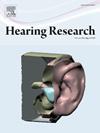Chronic tinnitus is quietened by sound therapy using a novel cross-frequency de-correlating stimulus modulation
IF 2.5
2区 医学
Q1 AUDIOLOGY & SPEECH-LANGUAGE PATHOLOGY
引用次数: 0
Abstract
We introduce a novel modulation of broadband sounds which eliminates correlations between all frequency pairs close to the tinnitus frequency, to reduce cross-frequency neural synchrony and thereby quieten tinnitus. Fifty-three unselected participants completed a blinded randomised crossover trial, which was run completely online using their computers or smartphones, comparing active to perceptually-near-identical sham stimuli, comprising two 6-week listening periods and 3-week washout periods. Results showed a significant, persisting, reduction in self-rated tinnitus loudness after the active (p = 0.012), but not sham (p = 0.916) intervention. Tinnitus distress scores decreased in both listening periods, indicating tolerability of the intervention and trial process. Due to its automation, generalisability across tinnitus types, and deliverability with generic hardware, this intervention could be made available to most of the worldwide tinnitus community at minimal cost. Next steps involve optimising the intervention parameters to maximise efficacy, and development of a software package for wholescale delivery.
慢性耳鸣是安静的声音治疗使用一种新的交叉频率去相关刺激调制
我们引入了一种新的宽带声音调制,消除了接近耳鸣频率的所有频率对之间的相关性,以减少交叉频率的神经同步,从而消除耳鸣。53名未被选中的参与者完成了一项盲法随机交叉试验,该试验完全在线运行,使用他们的电脑或智能手机,比较积极刺激和感知上几乎相同的假刺激,包括两个为期6周的倾听期和3周的冲洗期。结果显示,主动干预后自评耳鸣响度持续显著降低(p = 0.012),而假干预后无显著降低(p = 0.916)。耳鸣痛苦评分在两个听力阶段都有所下降,表明干预和试验过程的耐受性。由于它的自动化、跨耳鸣类型的通用性和通用硬件的可交付性,这种干预可以以最低的成本提供给世界上大多数耳鸣社区。接下来的步骤包括优化干预参数以最大化功效,以及开发用于批量交付的软件包。
本文章由计算机程序翻译,如有差异,请以英文原文为准。
求助全文
约1分钟内获得全文
求助全文
来源期刊

Hearing Research
医学-耳鼻喉科学
CiteScore
5.30
自引率
14.30%
发文量
163
审稿时长
75 days
期刊介绍:
The aim of the journal is to provide a forum for papers concerned with basic peripheral and central auditory mechanisms. Emphasis is on experimental and clinical studies, but theoretical and methodological papers will also be considered. The journal publishes original research papers, review and mini- review articles, rapid communications, method/protocol and perspective articles.
Papers submitted should deal with auditory anatomy, physiology, psychophysics, imaging, modeling and behavioural studies in animals and humans, as well as hearing aids and cochlear implants. Papers dealing with the vestibular system are also considered for publication. Papers on comparative aspects of hearing and on effects of drugs and environmental contaminants on hearing function will also be considered. Clinical papers will be accepted when they contribute to the understanding of normal and pathological hearing functions.
 求助内容:
求助内容: 应助结果提醒方式:
应助结果提醒方式:


